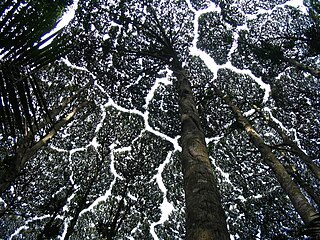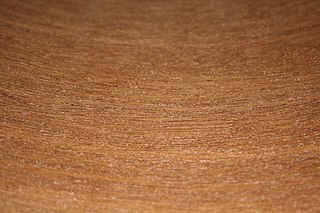
The crested gallito is a species of suboscine passerine bird in the tapaculo family Rhinocryptidae. It is the only species placed in the genus Rhinocrypta. It is found in Argentina, Bolivia, and Paraguay.

Parashorea malaanonan is a species of plant in the family Dipterocarpaceae. it is found in the Philippines and the northeast coast of Sabah in Borneo. The name malaanonan is derived from Tagalog and is a putative vernacular name for this species. It is a large emergent tree, up to 60 m, found in mixed dipterocarp forests on deep friable clay soils. It can still be found in forest reserves in the east coast of Sabah although elsewhere it is threatened by habitat loss. The timber is a light hardwood sold under the trade name of white lauan or white seraya.

Dryobalanops is a genus of flowering plants and the genus of family Dipterocarpaceae. The name Dryobalanops is derived from Greek and describes the acorn-like nut. The genus has seven species, confined to the tropical forests of West Malesia. It is among the most abundant species of emergent trees in these forests, growing up to 80 m tall.

Dryobalanops aromatica, commonly known as Borneo camphor, camphor tree, Malay camphor, or Sumatran camphor, is a species of plant in the family Dipterocarpaceae. The species name aromatica is derived from Latin and refers to the smell of the dammar (resin). This species was one of the main sources of camphor and attracted early Arab traders to Borneo, at that time being worth more than gold, and used for incense and perfumes.
Dryobalanops beccarii, or Kapur Keladan, is a species of plant in the family Dipterocarpaceae. The species is named after Odoardo Beccari, 1843–1920, an Italian explorer and botanist. It is found in Peninsular Malaysia and Borneo. It is a large emergent tree, up to 65 m tall, found in mixed dipterocarp forests on shallow leached soils over both sandstone and shale. It is a heavy hardwood sold under the trade names of Kapur. It is recorded from at least four protected areas.
Dryobalanops fusca is a species of plant in the family Dipterocarpaceae. The species name fusca is derived from Latin and refers to the dark coloured indumentum. This species is endemic to Borneo, where it is threatened due to habitat loss. It is a large emergent tree, up to 60 m tall, found in kerangas forests on raised beaches. It is a heavy hardwood sold under the trade names of Kapur.
Dryobalanops keithii is a species of plant in the family Dipterocarpaceae. The species is named after H.G. Keith, 1899–1982, a Conservator of Forests in North Borneo. This species is endemic to Borneo, where it is threatened due to habitat loss. It is a main canopy to low emergent tree, up to 40 m tall, found in mixed dipterocarp forest on well-drained but moist clay soils. It is a heavy hardwood sold under the trade names of Kapur.
Dryobalanops oblongifolia is a species of plant in the family Dipterocarpaceae, native to regions of Southeast Asia and Maritime Southeast Asia.
Dryobalanops rappa is a species of plant in the family Dipterocarpaceae. The species name is derived from Iban and refers to the species habitat. This species is endemic to Borneo. It is found in at least one protected area, but is threatened elsewhere due to habitat loss. The IUCN has assessed the species as endangered due to habitat damage by deforestation, mining, agriculture and fires.
Dipterocarpus confertus is a species of plant in the family Dipterocarpaceae. The species is named derived from Latin and probably refers to the indumentum. It is an emergent tree, up to 50 m (160 ft) tall. It is widespread in mixed dipterocarp forest on leached yellow clay soils up to 800 meters elevation. It is endemic to Borneo. The species is threatened by deforestation. It is a medium hardwood sold under the trade names of Keruing. It is found in at least one protected area.

Kapur is a dipterocarp hardwood from trees of the genus Dryobalanops found in lowland tropical rainforests of Malaysia, Indonesia and South-East Asia. It is a durable construction tropical timber. One variety, D. aromatica, is a source of camphor.

Cunninghamia konishii is an endangered species of tree in the cypress family, Cupressaceae. It is native to southeast China (Fujian), Taiwan, Laos and Vietnam.

Cunninghamia lanceolata is a species of tree in the cypress family, Cupressaceae. It is native to south-central and southeast China. Ornamentally C. lanceolata is commonly planted as a specimen tree in temperate zones.

Donella lanceolata is a plant species in the family Sapotaceae. It is a tree growing up to 30 metres (100 ft) tall, with a trunk diameter of up to 40 cm (16 in). The bark is grey to dark brown. Inflorescences bear up to 45 flowers. The fruit are brownish to purplish black, ripening yellow, round, up to 4 cm (2 in) in diameter. Its habitat is lowland forests from sea level to 700 metres (2,300 ft) altitude. Its natural range is Madagascar, India, Sri Lanka, Thailand, Cambodia, Laos, Vietnam, Malaysia, Brunei, Indonesia, the Philippines, Papua New Guinea, the Solomon Islands and Queensland.
Isonandra lanceolata is a plant in the family Sapotaceae. The specific epithet lanceolata means "spear-shaped", referring to the leaves.

Crown shyness is a feature observed in some tree species, in which the crowns of fully stocked trees do not touch each other, instead forming a canopy with channel-like gaps. This is most prevalent among trees of the same species, but also occurs between trees of different species. There exist many hypotheses as to why crown shyness is an adaptive behavior, and research suggests that it might inhibit spread of leaf-eating insect larvae.
Binsuluk Forest Reserve is a protected forest reserve on the Klias Peninsula, in Beaufort District of Interior Division, Sabah, Malaysia. It was designated as a Class 1 Protection Forest by the Sabah Forestry Department in 1992. Its area is 12,106 hectares (121.06 km2). The reserve is mostly flat, consisting mostly of peat swamp forest, with a small area of mangroves. The peat forests within this reserve, along with those in the nearby Klias Forest Reserve, are the last peat forests in Sabah.
Bukit Kuamas Forest Reserve is a protected forest reserve in Telupid District of Sandakan Division, Sabah, Malaysia. It was designated as a Class 1 Protection Forest by the Sabah Forestry Department in 1992. Its area is 7,324 hectares (73.24 km2). The reserve is hilly and surrounded by palm oil plantations. The forest is mixed dipterocarp. Threats to the reserve forests include logging, fires and erosion.
Hopea dryobalanoides is a tree in the family Dipterocarpaceae. The specific epithet dryobalanoides means "resembling Dryobalanops", referring to that genus of trees and particularly their leaf veins.

Schima superba is a species of flowering plant in the tea family Theaceae, native to subtropical areas of Vietnam, southern China, Hainan, Taiwan, and the Ryukyu Islands. With Pinus massoniana it often dominates forests from 100 to 800 m in elevation. It is used as a street tree in a number of southern Chinese cities.









